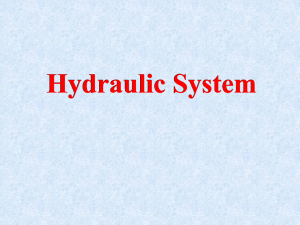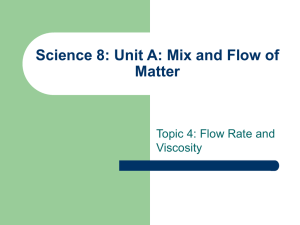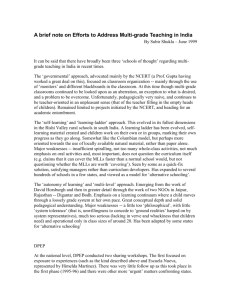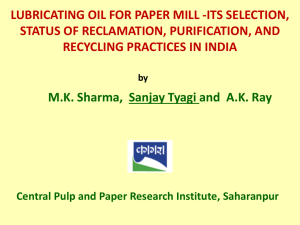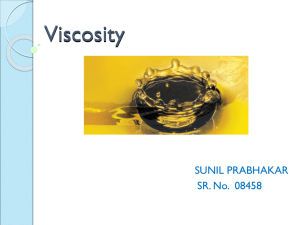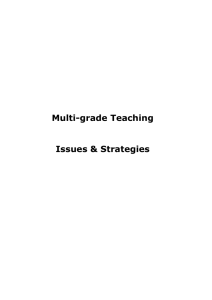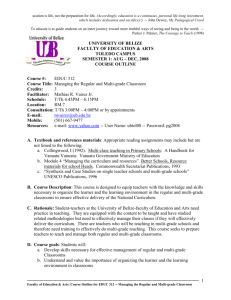Petro-Canada Lubricants - Alberta Forest Products Association
advertisement
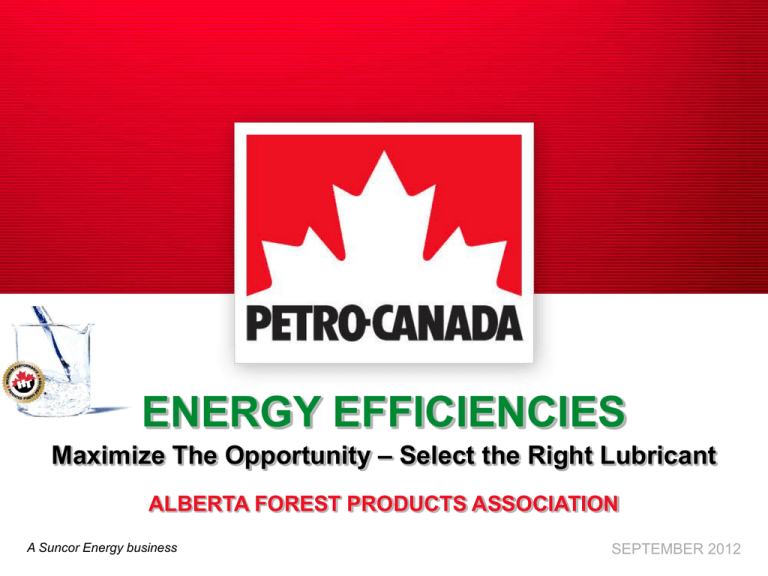
ENERGY EFFICIENCIES Maximize The Opportunity – Select the Right Lubricant ALBERTA FOREST PRODUCTS ASSOCIATION A Suncor Energy business SEPTEMBER 2012 OBJECTIVE • This presentation is to review the opportunities in reaching energy efficiencies and prolonging equipment and oil life in the forestry industry. – Traditional thinking • Indoor: Mono-grade oils • Outdoor: Multi-grade oils • We will discuss advantages of moving to multigrade lubricants indoors. 1 OPPORTUNITIES FOR CHANGE FORESTRY - INDUSTRY TRENDS • Overall reduction in costs (who isn’t) • Energy consumption reflects a substantial operational cost for the Forestry industry • Hydraulic systems are becoming smaller but more efficient resulting in higher temperatures and pressures • A typical hydraulic pump converts approx 20% of its horsepower into heat, therefore most fluids run at elevated temperatures • Gear design changes to improve efficiency require gear lubricants to work at higher temperatures. 2 OPPORTUNITIES FOR CHANGE • The trends and more severe requirements on today’s hydraulic and gear systems can and are met with existing high quality mono-grade (straight-grade, single-grade) oils. • However, further improvements in performance, as well as an added bonus in energy efficiencies is possible through the use of non-traditional products multi-grade oils in indoor applications. 3 FUNCTIONS OF A LUBRICANT • Reduce Friction • Minimize Wear (Keep Moving Surfaces Apart) • Cool Parts (Carry Away Heat) • Prevent Corrosion • Disperse Combustion or Oxidation by-products • Act as a Sealant • Transmit Power 4 WHY LUBRICATE? • Lubrication is key when sliding (area) contact is present. • Lubricants are used to reduce friction and wear by preventing metal to metal contact. Steel Air Steel No Lubricant: High Friction Steel Oil Film Steel Thin Film (Boundary) Lubrication: Moderate Friction 5 Steel Steel Full Film (Hydrodynamic) Lubrication: Low Friction FRICTION - 1986 NRC-ACOT REPORT • $5 Billion* per year is lost in Canada due to friction and wear • 25 - 30% is recoverable with existing technology 6 *NRC Report published in 1986 FRICTION - 1986 NRC-ACOT REPORT Friction Losses ($million/year) Wear Losses ($million/year) Total Losses ($million/year) 321 940 1,261 Electric Utilities 54 189 243 Forestry 111 158 269 Mining 211 728 940 Pulp and paper 105 382 487 Rail Transportation 284 467 750 Trucks and buses 126 860 986 14 189 203 1,226 3,913 5,139 Agriculture Wood Industries TOTALS 7 1986 to 2012 what is the $$ amount today? Significant opportunity to reduce friction losses LUBRICANT PROPERTIES • Viscosity is a measurement of resistance to flow at one temperature. • Viscosity Index (VI) is a measurement of the rate of change of viscosity over a range of temperatures. In simple terms: it measures how fast the oil thickens up as it gets colder or how fast it thins out as it gets hotter. • Generally the higher the VI the more allseason the product 8 VISCOSITY INDEX • Viscosity Index is an inherent property of the base oil used to blend a lubricant. – Some oils have naturally higher VI than others (i.e. Group II or synthetics) • VI can be improved significantly by blending soluble additives called VI Improvers (VII) into the oil. • These additives are long polymer molecules which uncoil at high temperatures to increase viscosity, while at low temperatures they form tight “balls” which no longer contribute much to viscosity. 9 Viscosity cSt (LOG-LOG) VISCOSITY INDEX IMPROVER (VII) Viscosity increase at low temperatures is relatively small resulting in cold temperature viscosity near original base oil. Base Oil + VII Multi-grade (all-season) Product (i.e. Hydraulic MV) Base Oil Mono-grade Product (i.e. Hydraulic AW) Temperature oC (LOG) 10 Viscosity Index Improver (VII) additive expands with higher temperatures resulting in a higher viscosity at high temperatures Potential reduction based on shear stability (i.e. quality) of VII. VISCOSITY INDEX IMPROVER (VII) Viscosity cSt (LOG-LOG) Gain in effective operating temperature range Multi-grade Product (i.e. Hydraulic MV 32) OEM Recommended Operating Range Mono-grade Product (i.e. Hydraulic AW 32) -20 40 Temperature oC (LOG) 11 100 OPPORTUNITIES FOR CHANGE • Although all indoor components may see benefits of multi-grade oils the two biggest opportunities in the forestry industry are: – Hydraulics – Gear systems 12 Viscosity (cSt) VISCOSITY IMPACT - HYDRAULICS 13 INDUSTRIAL GEAR APPLICATIONS • Basic Principles • Rolling at the pitch point • Sliding occurs above and below the pitchpoint Original animation by Doug Wrighte, UWA Modified by Fluid Life 14 HYDRAULIC PUMP EFFICIENCY Volumetric Efficiency: All pumps have internal leakage paths. Mechanical Efficiency: Energy is consumed to rotate pump and overcome fluid frictional losses. The amount of mechanical and volumetric loss in a pump is primarily a function of the fluid’s viscosity and lubricity properties. 15 HYDRAULIC PUMP EFFICIENCY 16 Ref: Evonik Industries SHEAR STABILITY IS IMPORTANT 17 Ref: Evonik Industries SHEAR STABILITY IS IMPORTANT 18 Ref: Evonik Industries OEMS LIMITS ON SHEAR STABILITY OEM Eaton/Vickers Poclain JCB OEM Volvo Construction Parker/Denison Komatsu HK-1 Caterpillar TO-4 Bosch/Rexroth Sauer/Danfoss Din 51524 Part 3/ ISO 6473 HM Type3 Kubota UDT John Deere 19 Max Shear Loss 10% 20 hr KRL 10% 40 min Sonic 10% 20 hr KRL 12% 20 hr KRL 15% 20 hr KRL 12% 20 hr KRL 15% 20 hr KRL 15% 20 hr KRL 15% 40 min Sonic 15% 40 min Sonic 15% 250 cycle Kurt Orhban 40 min Sonic Vis @ 100C min of 7.2 cst INDUSTRY - TEST RESULTS COMPONENT 20 TEST OILS % ENERGY SAVINGS Mono-grade Multi-grade Gear Pump Eaton L2 Series 2550 ISO 46 VI 100 ISO 46 VI 150 >4 Vane Pump Denison T6C ISO 46 VI 100 ISO 46 VI 150 >5 Piston Pump Komatsu HPV 35+35 ISO 46 VI 100 ISO 46 VI 150 >15 Ref: RohMax INDUSTRY – TEST RESULTS Source: Evonik Industries 21 INTERNAL HYDRAULIC OIL TESTS IMPROVEMENT AW vs. MV 6 % Improvement 5 4 3 2 1 0 50 60 70 Temperature C 22 80 9 GEAR OIL TESTS RESULTS Losses at 302 Nm 8.5 7.5 9 7 8.5 6.5 8 6 7.5 5.5 5 4.5 4 10 Torque Loss [Nm] Torque Loss [Nm] 8 GL-5 80W-90 Traxon XLBlend Synthetic Blend Synthetic 75W-90 75W-90 Synthetic 75W-9075W-90 Traxon Synthetic GL-5 80W-90 7 Traxon XL Synth 75W-90 Traxon Syntheti 6.5 6 5.5 20 30 40 50 Temperature [°C] 5 4.5 4 10 23 20 30 Temperature [°C] 40 50 FIELD TEST RESULTS SAE 10W Mono-grade Multi-grade ISO 32 Hours of Work / Drain Interval Hours 4000 4000 System Volume (gallons) 67.4 67.4 $/gallon $11.70 $6.09 $/litre $3.10 $1.61 Cost of Oil ($) $789 $411 0% 2.8% Fuel Consumed (gallons) 24,459 21,114 Fuel Costs ($/gallon) $2.50 $2.50 Total Fuel ($) $61,148 $52,785 TOTAL COSTS $61,936 $53,196 Energy Efficiency Gain • Test results indicated a fuel savings of 3.8% ($8740) Field trial done by vendor on a medium size excavator with dual piston pump feeding 3 piston motors (tracks and swivel) plus boom, stick and bucket cylinders (5000 psi / 345 bar max.) Each product ran for 4 days (~6 hours / day) 24 Results above are extrapolated to 4000 hrs using a Denison T6CM pump (B10 cartridge, 2000 rpm, 200 bar, 70oC) to benchmark field trial products and internal multi-grade. Since the efficiency of the pump is based on viscometric properties of the fluid at certain temperatures and pressure conditions, data can be accurately extrapolated from the field trial and bench tests to other products. SUMMARY • Significant opportunities are available to improve energy efficiencies by changing to multi-grade oils in applications otherwise suitable for mono-grade products. • Multi-grade hydraulic and gear oils that are shear stable will maintain viscosity and allow operations to run under wider temperatures • Improved shear stability results in improved energy efficiencies • Although much of the test results shown in this presentation are related to mobile equipment, the opportunities of energy efficiencies are relevant to all equipment based on the lubricant technology. • Selecting the right multi-grade oil saves money. 25 Thank-you for your time & interest


